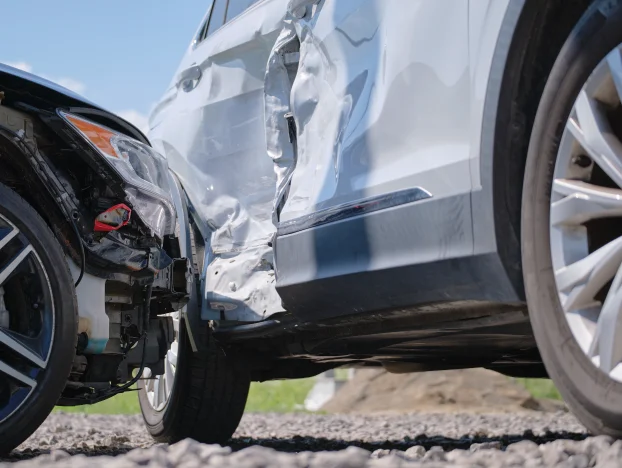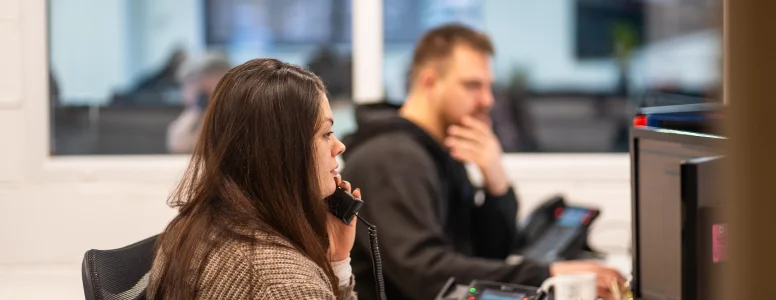To answer the question Side impact collision who’s at fault UK, you must understand the factors that caused the accident and what evidence to collect.

Once everyone involved is safe and emergency services have been called to help with injuries and road clearance, ensure to thoroughly examine the scene to determine who’s at fault.
Consider the factors that caused the accident:
Evidence to collect:
Below is an extensive guide on side impact collisions and how to prove a car accident wasn't your fault.


A side-impact car collision is a type of car accident that occurs when either:
These types of collisions can result in serious injuries for those involved and can often cause car damage as well.
While not all side-impact collisions are caused by negligent or reckless driving, they can be the result of careless behaviour on the part of one or more drivers.
Speak to a Non-Fault Claim Specialist
We manage everything on your behalf, ensuring that the claims process is as smooth and stress-free as possible.
Back to the top >

The factors that lead up to a side-impact collision can stem from a huge variety of situations. However, there are a handful of common causes that can result in these factors of the accident.
Understanding what the causes might have been in a particular side-impact collision circumstance may help in understanding who’s at fault in the UK.
At high speeds, it takes longer to stop the vehicle. Even if the driver who received the impact saw the collision coming, they may not have been able to avoid a collision.
Making matters worse, a force of an impact is much greater when a car is travelling at high speeds. This can cause greater injuries and even death to the occupants of one, if not all vehicles.
Distracted driving is a major cause of motor vehicle accidents.
One of the most common types of distraction is texting or using a mobile phone while driving.
It is known to be a common cause of accidents because it has been proven to reduce a driver’s ability to focus on the road and react quickly to changes in traffic or road conditions.
A non-fault claim can be difficult to succeed in if the non-fault driver isn’t able to prove that it wasn’t their fault.
The negative impact that this can have financially and emotionally on people is difficult.
However, the process in proving the car accident wasn’t your fault can be relatively straightforward. It all starts with:
It’s not just a mobile phone that can cause distractions while driving.
People may also be:
All of these types of distractions are particularly dangerous while behind the wheel.
When drivers are distracted:
These collisions are often serious and can result in major injuries to the driver or passengers in the impacted vehicle, if not both vehicles.
Driving under the influence of anything at all increases the chances of having an accident, not just a side impact collision.
Driving under the influence can have many different effects on people while behind the wheel, leading to a side-impact collision.
This includes examples such as:
Tailgating is dangerous driving behaviour that can increase the risk of an accident.
To avoid tailgating, the highway code provides specific stopping distance recommendations for all drivers.
When vehicles are travelling too close to one another, it becomes more difficult for either driver to react in an emergency situation, increasing the likelihood of a side-impact collision.
If you are involved in a side-impact car collision, it is important to seek medical attention immediately and contact the police.
Even if you do not feel like you were injured, it’s recommended to also seek medical assistance. It is critical that proper documentation be created so that you can pursue any personal injury claims you may have against the responsible driver.
To answer the question Side impact collision who’s at fault UK, you must understand the factors that caused the accident and what evidence to collect.
After a right turn collision, both drivers may be at fault. In some cases, the driver who made the right turn may be more at fault than the other driver.
If the driver who made the right turn did not take into consideration the right of way, he or she may be held responsible for the accident. The other driver may also be held responsible if he or she was speeding or driving recklessly.
There are a variety of reasons why right-turn collisions may occur, some of the most prevalent ones being:
By understanding some of the more common causes of right turn collisions, drivers can be more aware of their surroundings and take steps to avoid these types of accidents.
Auto Claims Assist can help you understand your rights and options after a side-impact car collision if it wasn’t your fault.
If you’d to speak to our new claims team, give us a call now or request a call back.
If you have been searching for ‘side impact collision who’s at fault UK’ It’s likely that you may have been involved in one of these accidents.
When assessing who is at fault in a car accident involving a side-impact collision, there are many factors to consider. Some of these include:
When assessing who is at fault in a car accident involving a side-impact collision, there are many factors to consider. Some of these include:
The key to establishing fault is through a calm approach directly after the accident, followed by detailed information and evidence gathering:
If you have been involved in a side impact collision accident, it is important to seek medical attention right away.
Even if you do not think you have been injured, it is important to get checked out in case there are any hidden injuries or complications. Contact the emergency services as a priority.
If you are injured, the police can also call an ambulance for you as well as provide any medical care needed in an emergency.
The police can also be a useful resource in helping to gather more evidence about the accident.
Following the accident it’s important you take notes about how the accident occurred including:
Collect any witness names and contact details. Your witness statement should cover the following questions:
Witnesses can aid in the evaluation of your claim by providing information on what occurred and how it occurred.
Media such as photographs and videos can aid in the presentation of evidence that the accident wasn’t your fault. Try to capture:
Additionally, if you can gain access to any local CCTV footage from nearby organisations, this can be a valuable resource to help piece together what happened.
Not everyone knows exactly what to do after a car accident, especially if the accident wasn’t your fault.
The most essential thing is to ensure that everyone is safe. If anybody has been hurt, call the emergency services first and don’t worry about anything else just yet.
Focus on gathering information and evidence about the incident when the danger has passed. This is crucial for submitting a non-fault claim.
Your first contact after the accident, if it wasn’t your fault, should be an accident management company (also known as a credit hire company) like Auto Claims Assist.
Some people think that the first thing they need to do after a non-fault accident is to contact their own insurance company.
In light of this, we have created a comparison between calling an accident management company vs your insurance company here here after a non-fault accident.
Using your own insurer could leave you worse off if the accident wasn’t your fault.
Start my claim →To speak to an advisor for advice and guidance on getting started after a non-fault claim, call 0330 128 1407.
To start your claim now, use our online claim form to submit your non-fault accident details.


Auto Claims Assist
First contact after a car accident
Start my claim online Call us on 0330 128 1407

Our team of non-fault claim specialists are ready to answer any questions you have. Provide your details here to request a callback. One of our advisors will call you back as soon as possible. Alternatively, call us on 0330 128 1407 to speak to someone now.
One of our team will give you a call